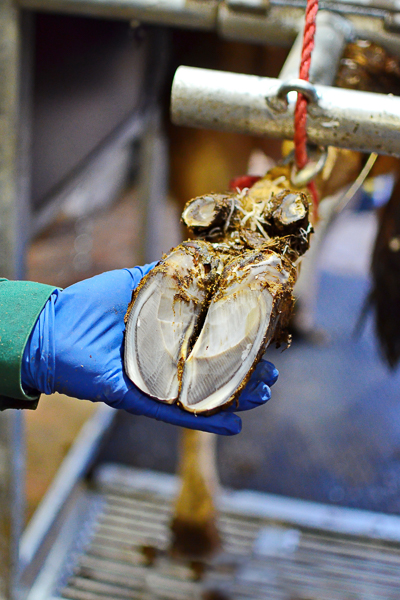
Lameness has a huge impact on the fertility, milk production and body condition of cows. The result is large amounts of time and energy spent treating cases and increasing culling, and then a consequential decrease in overall efficiency on farm.
Costs of lameness are estimated at between $200-$1,300/cow depending on the case, and, as you can imagine, the animal welfare impacts are huge.
On many farms, lameness is poorly recorded, and often only cows that receive an antibiotic or anti-inflammatory get noted down. All too often, those cows that are trimmed or treated with blocks for lameness do not receive medicine requiring withholds, and so they do not get recorded.
This can mean the actual number of cows treated for lameness each year is unknown, and the impact of lameness on farm is frequently underestimated. As a starting point I cannot overemphasize the importance of starting to record what you treat, whether that be on a whiteboard or notebook near the foot crush, in the Dairy NZ Healthy Hoof app, in MINDA, or on a shared WhatsApp group with farm staff etc.
Dairy companies are requesting annual reporting of incidences of lameness with schemes like Fonterra’s Co-operative Difference and Synlait’s Lead With Pride as they know the importance of this, so get ahead of the game and find out what is happening at home!
Alternatively, or in addition, start with a lameness scoring session. We have trained technicians who can come out and do this for you. Cows are scored from 0 to 3 depending on the severity of their condition. Cows who score 2 and 3 should be pulled out and examined. At a single scoring event, the best farms achieve around 4% cows at scores 2 and 3. If over 10%, we would recommend you investigate why, as this will be a developing welfare problem. Scoring can be done monthly in order to identify cows to be treated, catching them early and dealing with the problem before it becomes too severe.
If you are treating more than 8% of your herd each season, then you can improve profitability by reducing herd lameness. Vetlife has several Dairy NZ-trained Healthy Hoof providers who can investigate the risk factors for lameness on your farm. Risk factors for lameness include a range of things such as stockmanship and management, the shed and track infrastructure and each cow’s genetics and health history. We will delve into each of these areas and help you focus on those having the greatest impact. Please do contact us for more information on lameness prevention.
Many farm staff are treating their own cows’ feet, which is fantastic, as prompt treatment with regard to lameness is important. We offer on-farm training sessions that can cover:
All our vets and some of our technicians are trained in lame cow treatment. In painful cases and/or severe cases, local anesthetic (nil milk wh) can help us do a better job without causing undue stress to the cow. We have a portable lameness crush that we can bring out to farms if required.
So do not let your lame cows get out of control and allow us to help you treat them promptly. Call your local Vetlife clinic for more information.